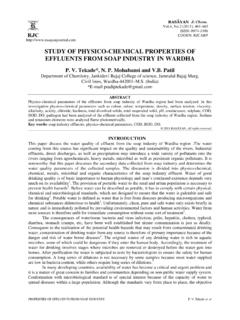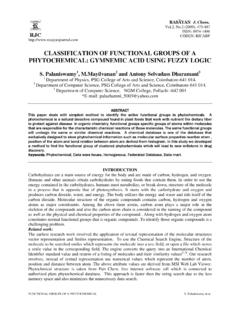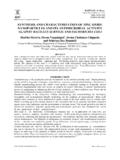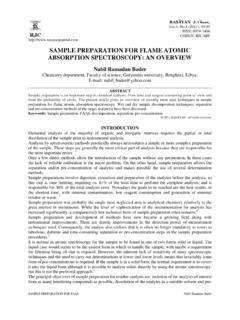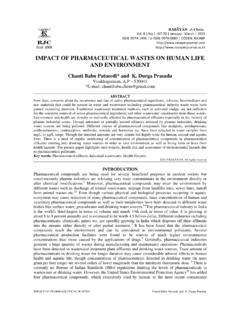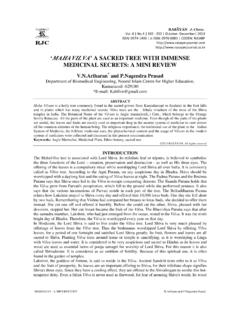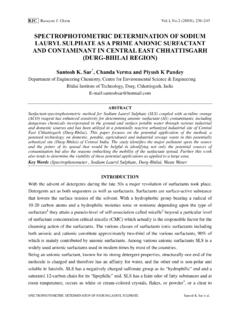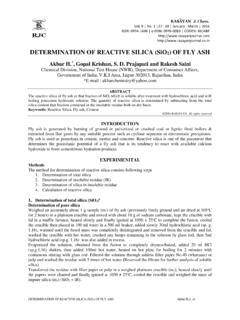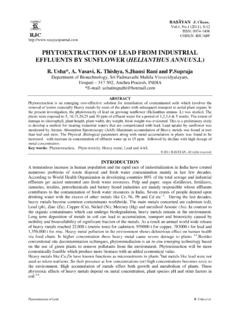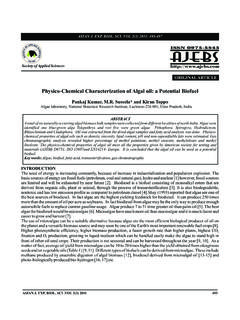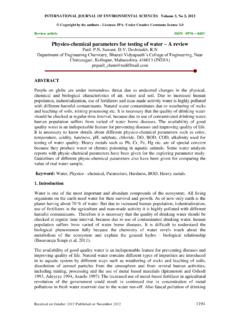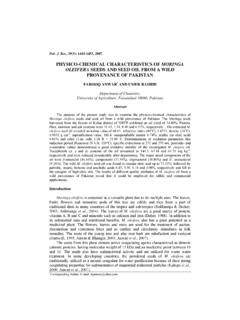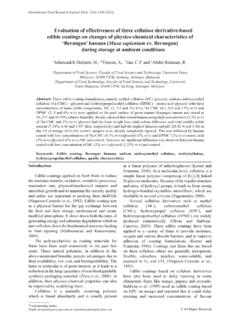Transcription of STUDIES ON PHYSICOCHEMICAL PARAMETERS TO ASSESS …
1 , (2009), 195-203. ISSN: 0974-1496. CODEN: RJCABP. STUDIES ON PHYSICOCHEMICAL PARAMETERS TO. ASSESS THE WATER QUALITY OF RIVER GANGA FOR. DRINKING PURPOSE IN HARIDWAR DISTRICT. Dhirendra Mohan Joshi1, Alok Kumar2, and Namita Agrawal2*. 1. Chemistry department, HNBG university, Srinagar, Garhwal ,India. 2. Chemistry department , Chinmaya college of Sciences, Haridwar, Uttarakhand , India. E mail : ABSTRACT. A systematic study has been carried out to ASSESS the water quality index of River Ganga in Haridwar District. 90 water samples from five sampling stations were collected and analysed for physico-chemical PARAMETERS (Temp, velocity, pH, dissolved oxygen, free CO2, , , Carbonate, Bicarbonate, total alkalinity, hardness, turbidity, calcium, magnesium, sodium, potassium, nitrate, phosphate, chloride, sulphate, electrical conductivity, total dissolved solids and total suspended solids.)
2 The study area experiences a seasonal climate and broadly divided into three seasons as winter (November to February), Summer (March to June) and rainy (July to October). The samples were collected and analysed for two consecutive years 2007 and 2008. Each parameter was compared with the standard desirable limit of that parameter in river water as prescribed by different agencies. The analytical data of various PHYSICOCHEMICAL PARAMETERS indicates that some PARAMETERS like pH, electrical conductivity, total dissolved solids , total suspended solids, turbidity and sodium are found to be in excess than the prescribed limit in some water samples of the study areas.
3 The WQI value indicates that water samples of some sampling stations are quite unfit for drinking purpose because of high value of dissolved solids and sodium. It was also observed that the water in the year 2007 was of a better quality than in the year 2008. Suitable suggestions were made to improve the quality of river water. Key words: Water pollution, Ganga river water, PHYSICOCHEMICAL analysis, Water quality index, potability. INTRODUCTION. Pollution of a river first affects its chemical quality and then systematically destroys the community disrupting the delicate food web.
4 Diverse uses of the rivers are seriously impaired due to pollution and even the polluters like industry suffer due to increased pollution of the rivers. River pollution has several dimensions and effective monitoring and control of river pollution requires the expertise from various of river is a global problem. In India it is reported that about 70% of the available water is polluted. The chief source of pollution is identified as sewage constituting 84 to 92 percent of the waste water. Industrial waste water comprised 8 to 16 percent. The indiscriminate and large scale deforestation and over grazing in the watershed areas of river basins have caused soil erosion resulting in considerable silting of dams and shrinkage of river flows.
5 This leads to the flooding of the rivers at the time of excessive rains2. The disposal of waste leads to contamination of river and lakes chronically affecting the flora and fauna. According to surveys carried out on selected stretches of important rivers, it has been found that most of the rivers are grossly polluted. The domestic sewage discharged from a population of about 2 millions gives rise to numerous water-borne diseases like typhoid, cholera, dysentery, poliomyelitis and cysticercosis, thereby affecting the human health and deterioration of the water quality3.
6 Ganga, the mighty Indian river originates from the snowed peaks of Himalayas, is the lifeline of millions of Indians. From its source to its entry in to the Bay of Bengal, it travels a distance of around 2525 Kms. The river with its well knit tributaries drains the Ganga Basin WATER QUALITY OF RIVER GANGA Namita Agrawal et al. , (2009), 195-203. which encompasses an area of more than a million square kilometers. (1060,000 sq km)spread over four countries- India, Nepal, Bangladesh and China4. Hardwar is a city in Northern India on the bank of the Ganga River north east of Delhi.
7 It is a Hindu pilgrimage centre. Hardwar lies along the Ganga River at the boundary between the Indo-gangetic plain (South) and the Himalayan foothills (North). The water supply of the Ganga system is partly dependent on the rains brought by the monsoon winds from July to October as well as on the flow from melting Himalayan glaciers in the hot season from April to June. The religious importance of Ganga may exceed than that of any other river in the world. For this study, the water samples were collected from five spots. Sampling station A (Bhooma Niketan), sampling station B (Jai Ram Ashram), Samping station C (Har-Ki-Pauri), sampling station D (Prem Nagar Ashram) and sampling station E (Pul Jatwara).
8 Sampling station A is situated in the north of Haridwar. The stream of the Ganga is separated from Malviya point and flows through Kharkhari via Jai Ram Ashram (sampling station B) and confluenced with second stream of Ganga river on the left side of Pant Dweep of Har-Ki-Pauri (sampling station C). A. number of pilgrims take their holy dip here, and their number is increased manifolds at the time of bathing festivals. The ashes and bones are also dumped here. Before this station, a cremation place is also situated and the effluents of Ashrams, hotels and other houses also enters the Ganga at Pant dweep.
9 Nullah of Bheemgoda and Kangra Mandir also opens here. The sampling station D (Prem Nagar Ashram). is situated downwards to Kankhal bridge. The domestic sewage mixes upstream to the sampling point. The last sampling station-E (Pul Jatwara) is situated in Jwalapur, where two Nullahs are joining the main stream towards upstream of the water flow. Accurate and timely information on the quality of water is necessary to shape a sound public policy and to implement the water quality improvement programmes efficiently. One of the most effective ways to communicate information on water quality trends is with indices.
10 Water quality index (WQI) is commonly used for the detection and evaluation of water pollution and may be defined as a rating reflecting the composite influence of different quality PARAMETERS on the overall quality of water. 5. The indices are broadly characterized in to two parts: the physico-chemical indices and the biological indices. The physico-chemical indices are based on the values of various physico-chemical PARAMETERS in a water sample, while biological indices are derived from the biological information and are calculated using the species composition of the sample, the diversity of species, their distribution pattern, the presence or absence of the indicator species or groups Here attempt has been made to calculate the water quality index of the Ganga river water in Haridwar on the basis of Harkins7, Lohani8 and subsequently modified by Tiwari 9 based on physico-chemical data.
